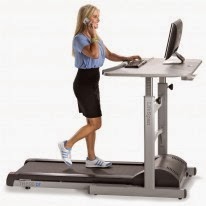
Here are smart ways to help prevent injury from using a treadmill desk.
Believe it or not, extremely slow walking, such as what’s done on a treadmill workstation, can actually result in repetitive stress injuries.
The problem is duration; people assume that extremely slow movement can never cause an injury, but when lengthy duration is added to the equation, then yes indeed, the seemingly benign treadmill workstation can result in an assortment of injuries.
What are the injury prevention strategies for a treadmill workstation?
“Gradually build up an acclimation to the treadmill desk, giving yourself some rest breaks from the treadmill to avoid repetitive strain (physically and mentally),” advises James Buenaventura, physical therapist in Harbor City, CA, who specializes in outpatient orthopedics and sports medicine as well as home health.
“Stretching before, during breaks, and after getting off of the treadmill may decrease excessive stress/strain from walking on the treadmill all day,” he adds. Use a timer if you must, to remind yourself it’s time to take a break.
Sitting for even just five minutes will give your feet a well-received break from repetitive motion.
The continuous motion of very slow walking on a tread is absolutely not the equivalent as the same length of time spent “walking” at the mall or inside a shopping center.
When people shop, not only do they make frequent pauses and end up standing virtually still while examining merchandise, but their feet shift direction frequently, whereas on a tread, the path is linear — more repetitive, which can give rise to repetitive stress injuries.
Nothing quite prepares you to use a treadmill desk for extended periods other than actually using this kind of device; I myself have a treadmill desk, and the first time I used it, after 30 minutes, my low back was aching, even though I regularly work out on a standard machine for one hour, which includes high intensity interval training with no low back ache!
What the devil happened? It’s the biomechanics of sustained, linear, super slow walking.
“The best injury prevention strategy would be to have a physical therapist or some other movement specialist inspect your walking/gait mechanics and see how you interact with the treadmill desk,” says Buenaventura.
“The physical therapist can make changes (either to the person or the desk/treadmill setup) to make sure you’re in the optimal position to minimize/decrease injuries.”










































